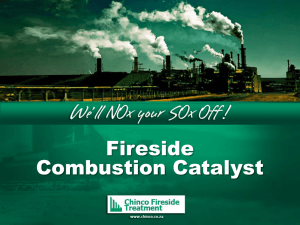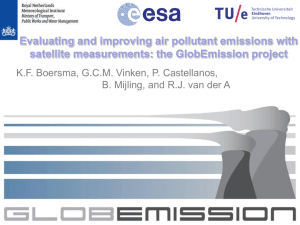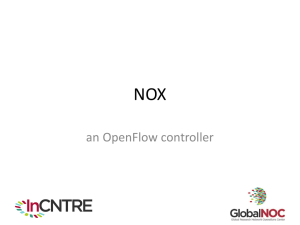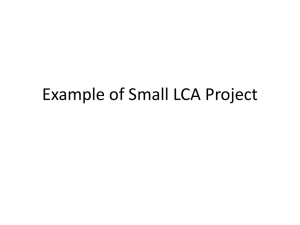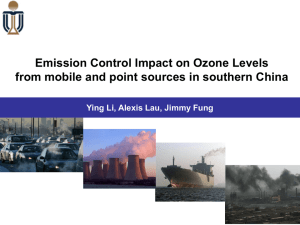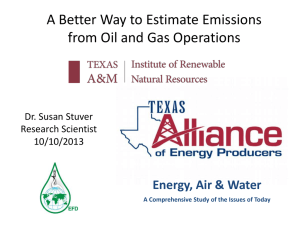*** 1
advertisement
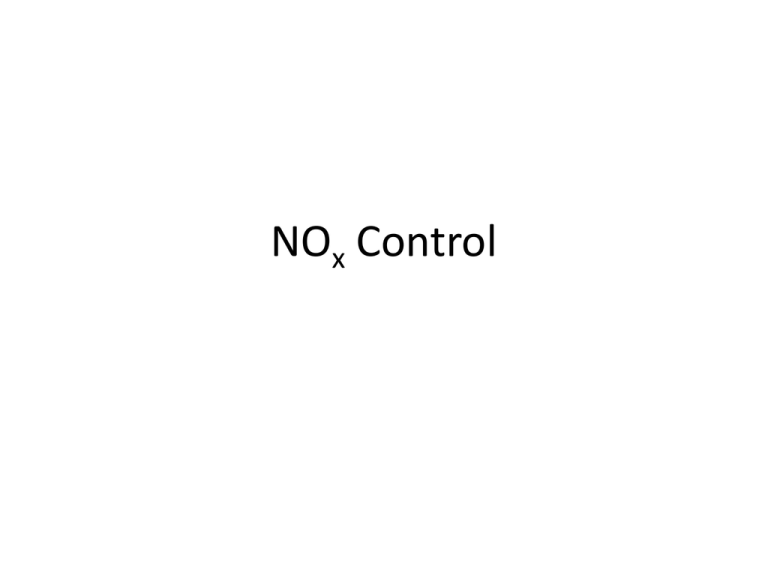
NOx Control Typical NO-NO2 emission ratios from combustion sources Source: USEPA, APTI 418, NOx Emissions Control from Stationary Sources NOx FORMATION MECHANISMS • The most universal of these is thermal NOX formation. In thermal NOX formation, NOX is formed by the reaction of N2 in the combustion air with combustion reactants such as O and OH radicals. Thermal NOX is emitted from virtually all combustion sources. • Fuel NOX is formed when the nitrogen bound in the fuel is burned. Obviously, the amount of NOX formed from this mechanism is a function of the amount of nitrogen in the fuel. Coal and residual oil have significant amounts of nitrogen that can generate half or three quarters of the total NOx emissions. Distillate oils such as #2 or diesel oil typically have very little nitrogen. Natural gas has no fuel nitrogen, and therefore no NOX is formed by this mechanism. • Prompt NOX, the third formation mechanism, forms NOX by converting molecular nitrogen to NO via intermediate products. This reaction occurs in the early phase in the flame front with hydrocarbons and is observed in laboratory research studies. While prompt NOx may be responsible for some of the NOx from practical combustors, it isn’t normally considered when dealing with NOx emissions control Source: USEPA, APTI 418, NOx Emissions Control from Stationary Sources Relation of thermal NOX formation and temperature Source: USEPA, APTI 418, NOx Emissions Control from Stationary Sources Source: USEPA, APTI 418, NOx Emissions Control from Stationary Sources Source: USEPA, APTI 418, NOx Emissions Control from Stationary Sources The main factors affecting the quantity of NOX formed by thermal fixation are: (1)the flame temperature, (2) the residence time of the combustion gases in the peak temperature zone of the flame, (3) the amount of oxygen present in the peak temperature zone of the flame. Thermal NOX reduction is therefore accomplished by various combustion modification techniques that either reduces the peak flame temperature or the oxygen in the primary zone, or both. These methods include: (1)reducing the local oxygen concentration at the peak flame temperature, (2) reducing peak flame temperature, (3) decreasing the furnace release rate Source: USEPA, APTI 418, NOx Emissions Control from Stationary Sources Fuel NOx • NOX generated from organically bound nitrogen contained in fuel is termed fuel NOX. Organic nitrogen (not N2) in the fuel burns along with the carbon and hydrogen. It either forms N2 or it forms NOx. Although only about 50% or less of the fuel nitrogen converts to NOx, fuel NOx can constitute most of the total NOx emissions from coal or any fuel with a high nitrogen content (excluding N2). • How much of the fuel nitrogen coverts to NOx depends on the oxygen levels in the flame. Consequently, the reduction of flame oxygen level is a key element in reducing the emissions that are formed by the fuel NOx mechanism. Source: USEPA, APTI 418, NOx Emissions Control from Stationary Sources Possible paths of fuel nitrogen contained in coal particles during combustion Source: USEPA, APTI 418, NOx Emissions Control from Stationary Sources Staged Combustion • Staged combustion burners, the most common type of low NOx burners, achieve lower NOx emissions by staging the injection of either air or fuel in the near burner region. • The division of combustion air reduces the oxygen concentration in the primary burner combustion zone, lowering the amount of NOx formed and increasing the amount of NOx reducing agents. Secondary and tertiary air complete the combustion downstream of the primary zone, lowering the peak temperature and reducing thermal NOx formation. Low NOx Burner Source: USEPA, APTI 418, NOx Emissions Control from Stationary Sources Source: www.ctre.iastate.edu/educweb/CE524/NOx.ppt Source: www.ctre.iastate.edu/educweb/CE524/NOx.ppt Reburning in a Utility Boiler Source: USEPA, APTI 418, NOx Emissions Control from Stationary Sources Flue Gas Recirculation (FGR) Flue gas recirculation (FGR), also called exhaust gas recirculatoin (EGR), works by mixing some flue gas with the incoming combustion air. This increases the mass flow through the combustion zone and decrease the concentration of O2 available for combustion. Increasing the gas flow in the combustion zone decreases the temperature, because the same amount of energy is distributed to a larger thermal mass. Source: USEPA, APTI 418, NOx Emissions Control from Stationary Sources Two versions of the concept of drawing gas from the exhaust ducts and mixing it with combustion air. The upper path, sometimes called “induced FGR” uses the ID fan inlet suction to draw gas from the stack. This increases the flow through the fan, but otherwise there is no energy penalty. The lower path, “active FGR” requires a dedicated fan and pumps relatively hot gas across is significant pressure differential into preheated combustion air which means that the FGR fan is fairly large. Active FGR systems use a significant amount of power. Source: USEPA, APTI 418, NOx Emissions Control from Stationary Sources Low Excess Air (LEA) combustion As shown in the figure, we can minimize diffusion flame NOx by reducing the excess air as far as possible without excessive CO or smoke. This highlights the need to control air flow precisely on any combustion system that is attempting to minimize NOx. Air flow needs to be maintained near the minimum practical (not quite smoking) level. The automatic air flow control system needs to do this continuously as the boiler load changes. Precise control of excess air is the first and most important step in controlling emissions from boilers and furnaces. This can only be achieved by using an O2 monitor tied into an intelligent (microprocessor based) control system. Source: USEPA, APTI 418, NOx Emissions Control from Stationary Sources The NOx creation rate typically peaks at excess oxygen levels of 5 – 7% where the combination of high combustion temperatures and the higher oxygen concentrations act together. At both lower and higher air/fuel ratios, NOx production falls off – due to lower flame temperature at high excess air levels and lower oxygen at low excess air levels. Source: http://www.cleanboiler.org/Images/RCT45xso.jpg Reducing NOx with Water Injection This figure is an example of the effect of water or steam injection on turbine emissions. Water injection is not commonly used in other types of combustion sources. Water injection in a turbine requires very clean water, but there is only a small penalty to engine efficiency. Water provides cooling that would otherwise have to be provided with air - because the maximum allowable turbine inlet temperature is far below the peak flame temperature in the primary zone. Source: USEPA, APTI 418, NOx Emissions Control from Stationary Sources For NO removal: 4 NO + 4 NH3 + O2 4 N2 + 6 H2O For NO2 removal: 4 NO2 + 8 NH3 + 2 O2 6 N2 + 12 H2O This reaction is called “selective reduction” because it uses a reagent to react with the NOx. Selective Non-catalytic Reduction (SNCR) • The first of these technologies was Thermal DeNOx. In this technology, ammonia is sprayed into the post-combustion area of a boiler or furnace when the temperature is 1650 °F. Under these condition, a 50% reduction of NOx can be achieved. • The reaction is temperature sensitive, and the window is small. If the temperature is to high, ammonia will convert to NOx faster than the reduction process. If the temperature is to low, the reaction with the NOx will not occur. • The NOxOUT process uses urea (CO(NH2)2) as a reactant instead of ammonia. The urea gives the technology a broader and slightly lower temperature window. Also, urea can be transported and stored as a solid. Source: USEPA, APTI 418, NOx Emissions Control from Stationary Sources Selective Catalytic Reduction (SCR) • The chemical reactions are the same as SNCR, but the reactions are catalytically driven. The temperature range depends on the catalyst used: • Conventional SCR Systems are called base metal systems. They usually use a Vanadium Pentoxide catalyst. The best performance will be in the range of 650° to 750°F. • For low temperature applications, Precious Metal is used, usually platinum. These systems can be used at temperatures as low as 350°F, and as high as 550°F. • High Temperature applications usually use Zeolite catalysts and have been used successfully at temperatures as high as 1050°F. Source: USEPA, APTI 418, NOx Emissions Control from Stationary Sources Source: USEPA, APTI 418, NOx Emissions Control from Stationary Sources SCR --Process Design Issues • NOx Removal Efficiency (impacts costs and ammonia slip) • Ammonia Slip (Consideration of catalyst life vs. ammonia slip) • SO2 Oxidation to SO3 • System Draft Loss (imposing backpressure on the combustion device) • Catalyst Life Expectancy • Ammonium Bisulfate Formation • Application Specific Issues Source: USEPA, APTI 418, NOx Emissions Control from Stationary Sources Source: www.ctre.iastate. edu/educweb/CE5 24/NOx.ppt Source: www.ctre.iastate.edu/educweb/CE524/NOx.ppt NSCR - Non-selective Catalytic Reduction • The catalytic reaction is based on the reaction between Nitrogen Oxides and a fuel to give nitrogen and water. The reducing fuel is generally chosen by site availability & price (typically Natural Gas, Light Naphtha or Hydrogen). • The fuel gas is introduced into the NOx process upstream where it homogeneously mixes before entering the catalytic bed. The following reactions take place: CH4 + 4NO2 ---> CO2 + 2H2O + 4NO CH4 + 4NO ---> CO2 + 2H2O + 2N2 • NSCR or three-way catalyst is used in rich-burn or stoichiometric engines for simultaneous conversion of NOx, CO, HC, formaldehyde and HAPs. NSCR catalysts are effective in a wide variety of engine applications and fuels, including natural gas, propane and gasoline. A closed loop air-fuel ratio controller is required for the three-way catalyst to work effectively. Source: http://www.netl.doe.gov/technologies/coalpower/cctc/cctdp/project_briefs/limb/limbdemo.html
